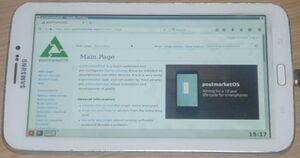Samsung Galaxy Tab 3 7.0 (samsung-lt023g): Difference between revisions
Appearance
mNo edit summary |
PureTryOut (talk | contribs) No edit summary |
||
| Line 13: | Line 13: | ||
| display = 1024×600 TFT | | display = 1024×600 TFT | ||
| memory = 1GB | | memory = 1GB | ||
| architecture = armhf | |||
| status_usbnet = Y | |||
| status_flashing = Y | |||
| status_touch = Y | |||
| status_screen = Y | |||
| status_wifi = | |||
| status_xwayland = Y | |||
| status_fde = Y | |||
| status_mainline = | |||
| status_battery = | |||
| status_3d = | |||
| status_accel = | |||
| status_audio = | |||
| status_bluetooth = | |||
| status_camera = | |||
| status_gps = | |||
| status_mobiledata = | |||
| status_sms = | |||
| status_calls = | |||
| booting = yes | |||
}} | }} | ||
Revision as of 13:23, 6 September 2018
| WARNING: This device is not recommended for future use with postmarketOS due to its armhf architecture. Alpine Linux (the distribution that postmarketOS extends) pmaports#599 has been considering dropping it. The processor of the device may support the armv7 architecture. If so, you can modify the device package and change the architecture accordingly. |
 Samsung Galaxy Tab 3 7.0 | |
| Manufacturer | Samsung |
|---|---|
| Name | Galaxy Tab 3 7.0 |
| Codename | lt023g |
| Released | 2013 |
| Hardware | |
| Chipset | Marvell PXA986 |
| CPU | Dual-core 1.2 GHz Cortex-A9 |
| GPU | PowerVR SGX540 |
| Display | 1024×600 TFT |
| Storage | 8GB |
| Memory | 1GB |
| Architecture | armhf |
| Software | |
| Original software | Android 4.4.2 on Linux 3.4.5 |
| postmarketOS | |
| Category | testing |
| Pre-built images | no |
| Flashing |
Works |
|---|---|
| USB Networking |
Works |
| Internal storage |
No data |
| SD card |
No data |
| Battery |
No data |
| Screen |
Works |
| Touchscreen |
Works |
| Multimedia | |
| 3D Acceleration |
No data |
| Audio |
No data |
| Camera |
No data |
| Camera Flash |
No data |
| Connectivity | |
| WiFi |
No data |
| Bluetooth |
No data |
| GPS |
No data |
| NFC |
No data |
| Modem | |
| Calls |
No data |
| SMS |
No data |
| Mobile data |
No data |
| Miscellaneous | |
| FDE |
Works |
| USB OTG |
No data |
| HDMI/DP |
No data |
| Sensors | |
| Accelerometer |
No data |
| Magnetometer |
No data |
| Ambient Light |
No data |
| Proximity |
No data |
| Hall Effect |
No data |
| Haptics |
No data |
| Barometer |
No data |

Entering flash mode
- Power down the device, then press and hold
Volume Down+Home+Powersimultaneously. - Once the device vibrates, release
Power, but keepVolume DownandHomeheld. - The device will ask you if you wish upload a custom OS. Press
Volume Upto confirm. - Once the device displays "Odin mode" in the top-left of the screen, it is ready for flashing.
Entering recovery mode
- Power down the device, then press and hold
Volume Up+Home+Powersimultaneously. - Once the device vibrates, release
Power, but keepVolume UpandHomeheld.
Installing the kernel
This can be done via pmbootstrap flasher flash_kernel after entering flash mode.
What works
- Booting off a microSD card
- Display
- Touchscreen
- USB networking
- Full disk encryption
- Physical buttons
- Touch keys
- Backlight brightness
- Battery indicator
- Wayland
- X11
What does not work
- Bluetooth
- Wi-Fi
- Cellular networking
Everything else is untested as of writing this.
Links
- Kernel source
- Unofficial TWRP
- #1484 Add support for the Samsung Galaxy Tab 3 7.0 (lt023g)